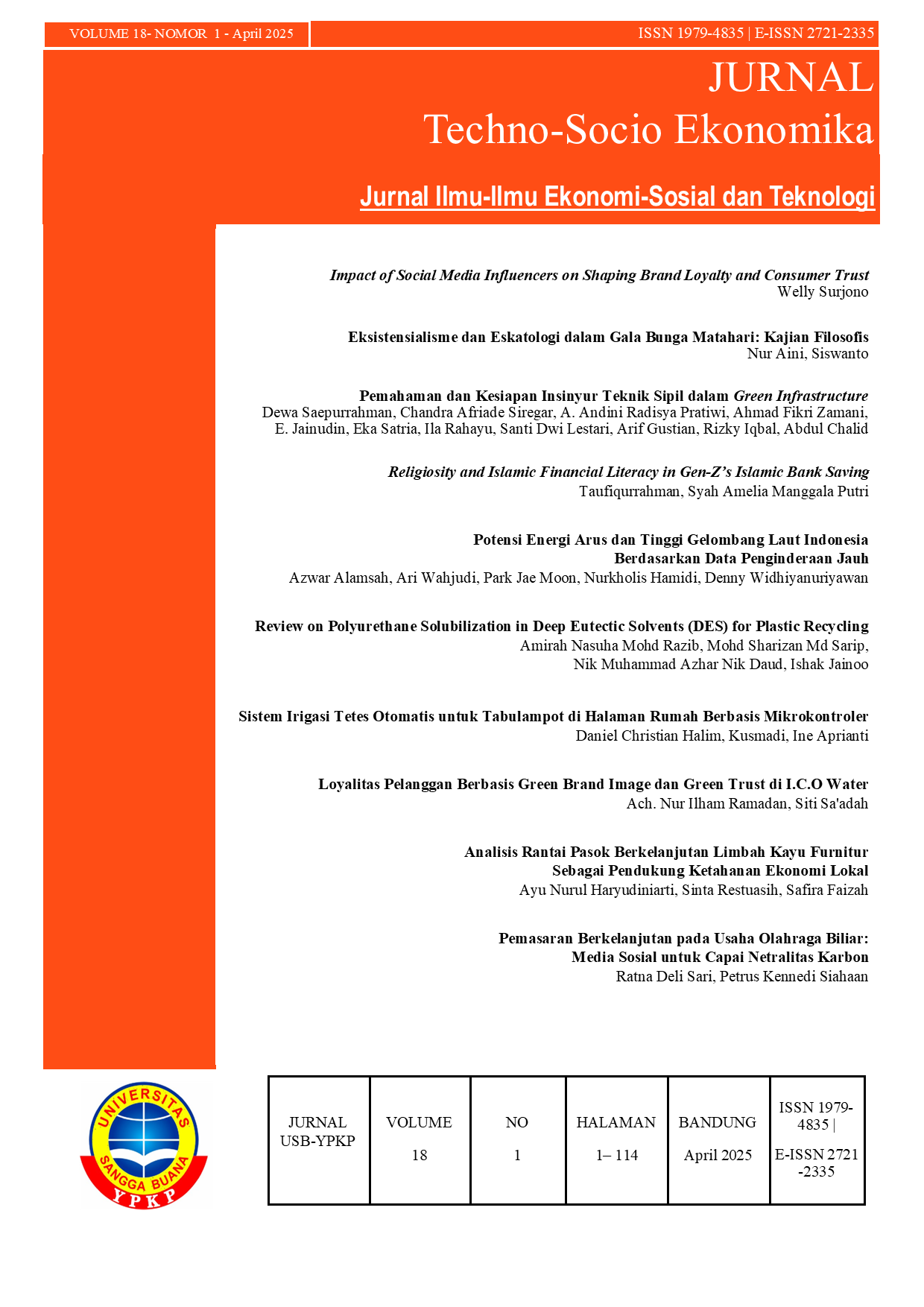Pemahaman dan Kesiapan Insinyur Teknik Sipil dalam Green Infrastructure
Isi Artikel Utama
Abstrak
Peningkatan suhu bumi yang semakin mengkhawatirkan sebagian besar dipengaruhi oleh aktivitas pembangunan, khususnya di sektor konstruksi. Pembangunan gedung dan infrastruktur menjadi salah satu kontributor utama emisi gas rumah kaca. Untuk mengatasi tantangan ini, sektor konstruksi perlu mengadopsi pendekatan yang lebih ramah lingkungan melalui konsep green infrastructure (GI) atau infrastruktur hijau. Penelitian ini bertujuan menganalisis pemahaman, kendala, dan kesiapan para insinyur, khususnya insinyur teknik sipil, dalam menerapkan GI. Dengan pendekatan kuantitatif melalui survey dan dianalisis menggunakan teknik statistik, penelitian ini mengidentifikasi persepsi, hambatan, serta pendorong kesiapan mahasiswa Magister Teknik Sipil Universitas Sangga Buana. Responden dikelompokkan berdasarkan latar belakang pendidikan: Teknik Sipil, Teknik Lain, dan Non-Teknik Sipil. Hasil analisis menunjukkan bahwa mahasiswa Teknik Sipil memiliki tingkat pemahaman dan kesadaran yang lebih tinggi terhadap GI dibandingkan kelompok lainnya. Hal ini dipengaruhi oleh kurikulum Teknik Sipil yang lebih menekankan aspek keberlanjutan dalam pembangunan infrastruktur. Namun, penerapan GI masih dihadapkan pada kendala seperti tekanan biaya, kurangnya pelatihan, dan minimnya dukungan manajemen. Secara keseluruhan, insinyur berlatar belakang Teknik Sipil menunjukkan kesiapan lebih tinggi untuk mengadopsi konsep infrastruktur hijau. Penelitian ini menunjukkan pentingnya untuk lebih memperdalam kurikulum tentang infrastruktur hijau untuk menghadapi tantangan pembangunan berkelanjutan, baik itu untuk Teknik Sipil ataupun teknik lainnya.
Rincian Artikel

Artikel ini berlisensi Creative Commons Attribution-NonCommercial-NoDerivatives 4.0 International License.
Penulis memegang hak cipta dan memberikan jurnal hak penerbitan pertama dengan karya yang dilisensikan secara bersamaan di bawah Creative Commons Attribution 4.0 International License yang memungkinkan orang lain untuk berbagi karya tersebut dengan pengakuan atas kepengarangan karya dan publikasi awal dalam jurnal ini.
Referensi
IPCC Working Group 1 I, Stocker TF, Qin D, Plattner GK, Tignor M, Allen SK, et al. IPCC, 2013: Climate Change 2013: The Physical Science Basis. Contribution of Working Group I to the Fifth Assessment Report of the Intergovernmental Panel on Climate Change. Ipcc. 2013;AR5(September 2014):1535.
United Nations Climate Change Global Innovation Hub. UN Climate Change Global Innovation Hub. 2022;(March). Available from: https://unfccc.int/topics/un-climate-change-global-innovation-hub#eq-8
Allan J, Bansard J, Jones N, Luomi M, Tan JM, Sun Y. Glasgow Climate Change Conference: 31 October – 13 November 2021. Earth Negot Bull. 2021;12(793):1–40.
Goubran S, Cucuzzella C. Integrating the Sustainable Development Goals in Building Projects. J Sustain Res. 2019;1(2).
Heryana D, Firmansyah A. Green Infrastructure Framework: Sebuah Strategi Pembangunan Infrastruktur Hijau Nasional. J Law, Adm Soc Sci. 2024;4(2):172–85.
Utsev T, Tiza M, Sani HA, Sesugh T. Sustainability in the civil engineering and construction industry: A review. J Sustain Constr Mater Technol. 2022;7(1):30–9.
Haron A, Omayer HM. Knowledge, Perception, and Intention of Professionals Related to the Transformation from Gray to Green Infrastructure in Egyptian Cities. IOP Conf Ser Earth Environ Sci. 2022;1113(1).
Siqueira MSS, Nascimento PO, Freire AP. Reporting Behaviour of People with Disabilities in relation to the Lack of Accessibility on Government Websites: Analysis in the light of the Theory of Planned Behaviour. Disabil CBR Incl Dev. 2022;33(1):52–68.
Tayouga SJ, Gagné SA. The socio-ecological factors that influence the adoption of green infrastructure. Sustain. 2016;8(12).
Wang Y. An Analysis of Influencing Factors on Sustainable Construction Behavior Based on Theory of Planned Behavior. IOP Conf Ser Earth Environ Sci. 2018;170(3).
Sugiyono. Metode Penelitian Kuantitatif, Kualitatif, dan R&D. Alfabeta: 2013.

